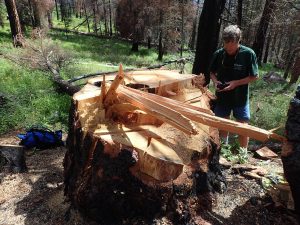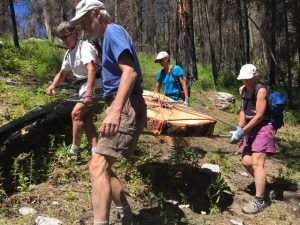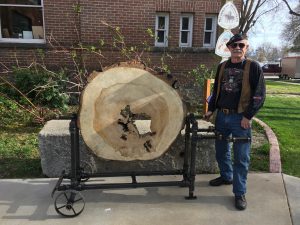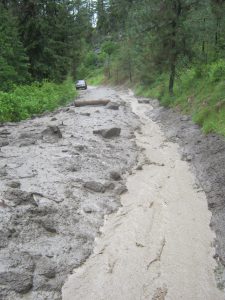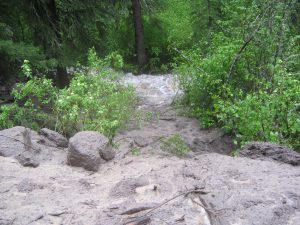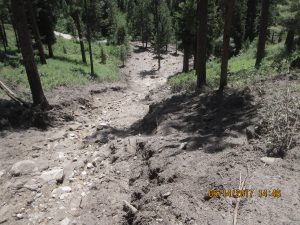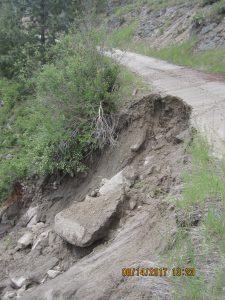The Story of the Camas Pine:
Jeff Lonn Discovers the Camas Pine June of 2018
In both May of 2017 and May of 2018, a Bitterroot National Forest Fire Crew was training on the southeast face of Ward Mountain, in an Inventoried Roadless Area (IRA) shown as old growth on BNF maps. For practice and to get a certain chain saw certification, they were cutting and using explosives to fell large Ponderosa Pine snags killed in the 2016 Roaring Lion fire. This area was a favorite of mine because of all the huge, old trees and the remote feel away from trails. While many of the old trees had been killed by the fire in one area, overall, most of the old grove had survived. But I estimated that during the two years of training, the crew had felled more than 40 large snags. After I found a snag taken down with explosives outside the fire perimeter that had not been killed by the wildfire, I became concerned about the impacts of this training on the old growth forest, and I emailed Dave Lockman, BNF wildlife biologist, and Julie King, BNF supervisor. I never received any response. Then, in late June, 2018, I discovered that this same training crew had also cut down a huge living Ponderosa in the same area. I counted the rings and was astounded to find that the tree was about 600 years old.
The Alta Pine, 800 years old, that was killed by arsonists in 2008 had been regarded as the oldest Ponderosa Pine in Ravalli County. It’s interesting that Big Pine, the biggest Ponderosa in Montana, near Tarkio, is only 350 years old. The oldest living known Ponderosa is 950 years old (in central Utah). In any case, this pine was a very significant tree, and may have been one of the oldest Ponderosa Pines in Ravalli County, if not Montana.
At what point do these activities constitute salvage logging and require environmental review? What are the ecological impacts of these activities to old growth and the IRA? Why was this tree allowed to be cut? I asked these questions of Julie King and Eric Winthers, Darby district ranger, and received only vague responses saying the training was important and the tree was dying anyway, which was not true (and aren’t we all dying, eventually?). To my knowledge, no one in the Forest Service has ever been held accountable, and no policies have been re-examined or changed. You can be sure I will be up there again this May to keep an eye on the remnants of our old growth forest.
FOB cuts a cookie and carries it to the public
The Camas Pine was green and alive when it was cut down in the spring of 2018 as part of the Bitterroot National Forest chain saw training practice. It was 565 years old. It had survived many wildfires over the century including the recent Roaring Lion Fire. It was just a seedling the year the Middle Ages ended (1453).
Here are just a few of the historical events in the life of the Camas Pine
- End of the Middle Ages 1453
- Columbus 1492
- William Shakespeare born 1564
- American Independence 1776
- Lewis and Clark travel through Bitterroot 1805
- Slavery abolished in US 1863
- Bitter Root Forest Reserve established 1898
- John Muir born in Scotland 1838
- Yellowstone becomes the worlds first National Park 1872
- Stihl invents the chain saw AKA "tree felling machine" 1929
- Rachel Carson’s Silent Spring 1962
- Wilderness Act 1964
- National Environmental Policy Act (NEPA) signed into law 1970
- Endangered Species Act Signed 1973
Wil Wilkins Creates a Mobile Stand to Share the Camas Pine with the Public
In order to share the Camas Pine with the public, Wil Wilkins volunteered to create a traveling stand to display the cookie. The stand is a work of art in and of itself. The Pine will be on display at the Ravalli County Museum when it is not featured at events around Montana.
BNF proposes clear-cutting Old Growth
Old Growth pine (minimum 170 years old, 21" in diameter) is rare in the Bitterroot National Forest (BNF). Only one third of the historical average of Old Growth remains in our forest. The 2006 Bitterroot Forest Plan document called for increasing Old Growth by 25-75%. But despite the rarity of Old Growth and public demand to protect it, BNF is planning to log Old Growth on a large scale for the first time in decades (Gold Butterfly Draft Environmental Impact Statement). In fact, BNF proposes to CLEAR-CUT acres and acres of Old Growth in the Gold Butterfly Project.
Old Growth forest is simply too rare, too valuable, and too special to cut. Many Old Growth species will be impacted like northern rockies fisher, flammulated owls and pileated woodpeckers. All large diameter trees should be left to protect existing Old Growth and to promote future Old Growth.
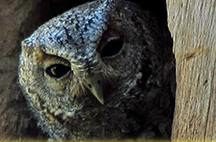
Two Ways to TAKE ACTION ON GOLD BUTTERFLY
- Forest Service policy should change to protect living Old Growth Trees and the largest snags that benefit so much wildlife. Chainsaw practice is needed and should not be eliminated but should be more limited in scope and a biologist should be present to avoid felling nesting sites.
- Call or e-mail Ranger Eric Winthers whose district includes the Camas Pine: 406-821-3913 or ewinthers@usda.gov
- Call or e-mail Forest Supervisor Matt Anderson to recommend reviewing and changing forest service policy on chainsaw practice: 406-363-7100 or mdanderson@usda.gov
- Let your voice be heard on the Gold Butterfly project. Tell them these 3 simple things:
- Old Growth trees should not be cut
- No large Clear-cuts especially in Old Growth trees
- No new roads, we have more than we can maintain
- Call or e-mail Forest Supervisor Matt Anderson 406-363-7100 or mdanderson@usda.gov
- Call or e-mail Project Leader Jeff Shearer 406-375-2608 or jeffrey.shearer@usda.gov
Gold Butterfly Timber Sale
The problem of deferred road maintenance has become routine on the Bitterroot National Forest. In the case of Willow Creek road, sediment chronically erodes into “water quality limited” Willow Creek, a bull trout bearing stream. The chronic problem became acute after record breaking rains on June 13, 2017. The Willow Creek road would be the primary loghaul route for the huge proposed Gold Butterfly timber sale. While the BNF loses millions of taxpayer dollars logging public forest, they don’t have the budget for timely road maintenance. And their own statements seem to indicate they don’t recognize the full extent of the problem. The Gold Butterfly timber sale project would build 8 more miles of road in this area where they can’t maintain what is already there. Deferred logging can result in old growth forest; deferred road maintenance can result in dead fish.
Below debris flow, FR#969 – Willow Creek Road, primary haul road for proposed Gold Butterfly timber sale.
Debris flow going off road into Willow Creek, already listed as impaired by MT DEQ due to road sediment.
Debris flow burying Willow Creek Road and flowing into Willow Creek.
Origin of debris flow, Willow Creek Road, switch back north of Willow Creek. No erosion on nearby un-roaded slopes.
The Bitterroot National Forest Gold-Butterfly public presentation overview document states, "most of the project area contains a well-developed road system; primary Forest Service (FS) roads are in good condition."
As can be seen in these photos, Willow Creek Road, and possibly other project roads need not just maintenance, but reconstruction to meet BMP (Best Management Practices) requirements. The Ravalli County portion of Willow Creek Road needs repair also. The cost to taxpayers to bring just main haul-roads up to standards, will be very high.
Forest Service road maintenance backlog in Montana was almost $500 million in 2004.
For more information LINK
Grizzly Recovery Plan
Northern Continental Divide Ecosystem (NCDE)
OR COMMENT: COMMENTS DUE OCTOBER 26, 2018
Email FWPGRIZZLYBEARARM@mt.gov or write to Grizzly Bear ARM, MDFWP, PO Box 200701, Helena, MT 59620-0701!
Talking Points:
- A 90% probability of maintaining 800 bears in the NCDE core is an inadequate target. How many bears and how much habitat is needed for a single, connected population in the Yellowstone, NCDE, Cabinet-Yaak, Selkirks, and Selway-Bitterroot ecosystems?
- The "lower 48" grizzly bears were listed under the ESA as "threatened" with extinction. Why are MDFWP and U.S. Fish and Wildlife Service trying to "divide and conquer" rather than "connect and recover" these ecosystems?
- Grizzly bears are currently confined to about 2% of their former range and numbers. MDFWP should be ashamed to try and write into Montana law that this constitutes bear "recovery."
- Grizzly bear hunting would kill bears needed for population expansion and ecosystem connectivity. If you want to write a law, make grizzly bear trophy hunting illegal in Montana forever.
- Connectivity is key. The Sapphires must be listed as a recovery zone if there is ever a chance to connect the NCDE grizzlies with the Yellowstone grizzlies. Numbers mean nothing without zones of connectivity between known grizzly populations. The original ESA ruling declared the entire population as endangered and called for connecting all recovery zones as one population. This is the only way to assure genetic vigor and the health of the grizzly population to assure numbers.
- The recent Yellowstone ruling considered the counting method used by FWS as inadequate.
Montana Wilderness Study Act
Nine particularly important wildland areas of Montana were established as Wilderness Study Areas by Congress in 1977 by the Montana Wilderness Study Act (S. 393). Senator Lee Metcalf of Stevensville sponsored the Act. The late FOB steering committee member Clif Merritt, of Hamilton, was instrumental in identifying and selecting the nine areas based on their major importance for Wilderness designation, threats to their wilderness attributes, and substantial local support.
In testimony on S. 393, the late Bitterroot wildland advocate Doris Milner referenced salient facts that suggested the need for more Wilderness, including the decline in maximum size and quantity of the large areas (>100,000 acres) at the national level as well as the increasing rate of use of Wilderness areas. She answered opponents question “How much wilderness do we need?” by asking “How do we retain what little pristine remains?” Her answer was that 5-393 was a partial solution.
The Act says, “[Montana's WSAs] shall, until Congress determines otherwise, be administered by the Secretary of Agriculture IUSFS] so as to maintain their presently existing wilderness character and potential for inclusion in the National Wilderness Preservation System.” The idea was to protect the wilderness quality of these special places before the incessant press to develop overtook the chance to fully protect them within the Wilderness System.
The Forest Service failed to maintain 1977 “existing wilderness character” as they failed to regulate the explosive increase of motorized recreational vehicle use on many of Montana's WSAs, including here on the Bitterroot National Forest (BNF) in the Blue Joint WSA and especially in the Sapphire WSA. For about twenty years FOB has monitored the Sapphire, Blue Joint and West Pioneer WSAs and documented damage caused by inappropriate and illegal motor vehicle use. In October 1996, FOB filed suit as a co-plaintiff in Montana Wilderness Association v. U.S. Forest Service, Case No. 96-152-M-DWM (D. Mont.), a case challenging the Forest Service's management of Montana's WSAs. After many years in Federal District Court and the Ninth Circuit Court, the case went clear to the US Supreme Court where in 2004 it was, in effect, dismissed without being ruled on. Since that time, several court cases involving failure to maintain wilderness character in specific WSAs have reinforced the clear mandate to maintain wilderness character. One court ruling that reinforced the need to limit levels of motorized use to that in 1977 also noted “Congress did not, however, mandate that motorized recreational levels be maintained.” Finally, in 2016, the BNF Travel Plan prohibited motorized and mechanized vehicles in the SWSA and BJWSA.
Blue Joint Wilderness Study Area
The Blue Joint WSA near Painted Rocks Lake is 68,000 acres of prime wildlands, including over 65,000 acres on the Bitterroot NF, contiguous with the Frank Church – River of No Return Wilderness and the Selway – Bitterroot Wilderness. Elevations range from 4,900 feet to 8,600 feet. Slopes on over half the area exceed 60%. Whitebark pines, a valuable food source, grow at the higher elevations. The large BIue Joint meadows provide diversity of habitat. This WSA serves as a buffer between the Big Wilderness to the west and development from the east pushing in from the southern end of a fast-growing Bitterroot Valley. The BJWSA provides dependable clean water at the head of the Bitterroot River as well as habitat for wildland species.
Sapphire Wilderness Study Area
FOB believes the Sapphire WSA is one of the most biologically valuable areas in the Bitterroot. It is approximately 98,000 acres in size, about 25 miles long and 5 to 10 miles wide, ranging from 5,000 feet to 9,000 feet in elevation. It contains numerous lakes and large meadows. Adjacent to the Anaconda – Pintler Wilderness, it serves as a critical wildland link in the Sapphire crest regional wildland biological corridor, providing premium value in this age of climate change due to its cooler high elevation secure habitat and north-south orientation, offering a path for migration to the north. The corridor has proven itself. Grizzly bears have wandered back to the Bitterroot along the Sapphires. Whitebark pine on the crest and swaths of huckleberry bushes provide important food sources for bears. A dwindling mountain goat herd and imperiled wolverines live there.

